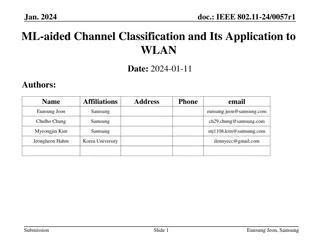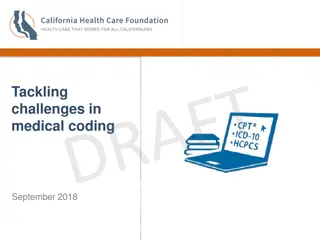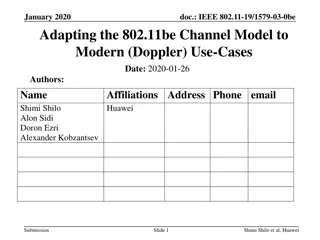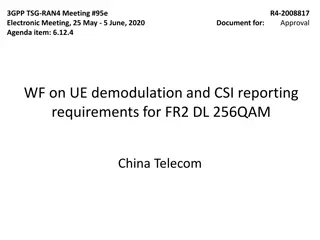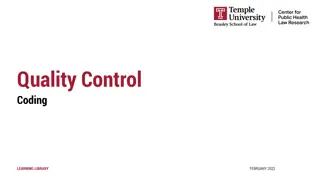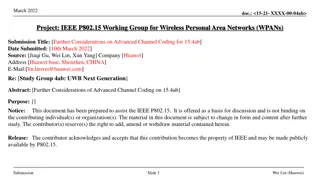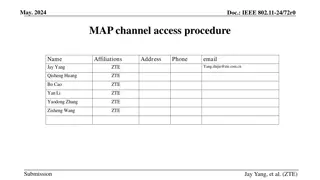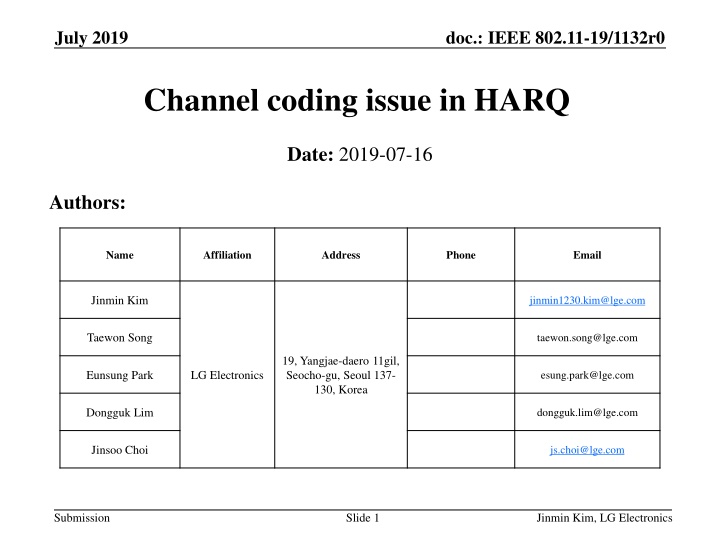
Channel Coding Issue in HARQ: A Deep Dive into IEEE 802.11-19/1132r0
Explore the intricate realm of channel coding challenges in HARQ systems as discussed in IEEE 802.11-19/1132r0. Delve into topics such as HARQ methods, link adaptation, collision issues, and more. Gain insights into LDPC and BCC performance in short packet scenarios, shedding light on puncturing bit impacts and optimal MCS selection.
Download Presentation

Please find below an Image/Link to download the presentation.
The content on the website is provided AS IS for your information and personal use only. It may not be sold, licensed, or shared on other websites without obtaining consent from the author. If you encounter any issues during the download, it is possible that the publisher has removed the file from their server.
You are allowed to download the files provided on this website for personal or commercial use, subject to the condition that they are used lawfully. All files are the property of their respective owners.
The content on the website is provided AS IS for your information and personal use only. It may not be sold, licensed, or shared on other websites without obtaining consent from the author.
E N D
Presentation Transcript
July 2019 doc.: IEEE 802.11-19/1132r0 Channel coding issue in HARQ Date: 2019-07-16 Authors: Name Affiliation Address Phone Email Jinmin Kim jinmin1230.kim@lge.com Taewon Song taewon.song@lge.com 19, Yangjae-daero 11gil, Seocho-gu, Seoul 137- 130, Korea Eunsung Park LG Electronics esung.park@lge.com Dongguk Lim dongguk.lim@lge.com Jinsoo Choi js.choi@lge.com Submission Slide 1 Jinmin Kim, LG Electronics
July 2019 doc.: IEEE 802.11-19/1132r0 Recap on [1-16] So far, even if the amount of gain is different, [1-16] show the benefit and throughput gain of HARQ And, various issues (e.g. HARQ method(CC/IR), link adaptation, collision issue, error check unit, HW complexity, HARQ-SIG design, etc) are discussed To strengthen the merit of HARQ, we simulate HARQ performance with both BCC and LDPC in short packet case Submission Slide 2 Jinmin Kim, LG Electronics
July 2019 doc.: IEEE 802.11-19/1132r0 LDPC in short packet In general, parity check matrix is designed to have a best performance when there is no punctured bits in a codeword block. However, in practical system, since the size of information bit is variable, puncturing/repetition almost always occurs. Moreover, if there are many punctured bits, the performance can be degraded. In BCC case, there is no restriction about information size if we consider reasonable information size which is enough longer than trellis length Furthermore, short packet causes the retransmission overhead increase due to large PHY preamble portion of short packet So, we d like to verify HARQ performance in short packet case Submission Slide 3
July 2019 doc.: IEEE 802.11-19/1132r0 The number of punctured bits In spec., the number of punctured bits is computed by following equation ?????= ???(?, ??? ????? ??????? ????? The BW, number of information bits, MCS and Nss are the factors to calculate the number of punctured bits When we assume reasonable packet length(>100bytes, e.g. VoIP, Appendix 1), The table below shows the maximum puncturing case per MCS MCS(20MHz, Nss=1) 0 1 2 3 4 5 6 7 Information size(bytes) 247B 247B 238B 162B 248B 329B 373B 417B The number of punctured bits per CW 296bits 278bits 138bits 268bits 126bits 173bits 128bits 84bits Ratio % (Punctured bits/parity bits) 30.5% 28.6% 28.4% 27.6% 25.9% 26.7% 26.3% 25.9% Submission Slide 4 Jinmin Kim, LG Electronics
July 2019 doc.: IEEE 802.11-19/1132r0 Performance in short packet (ARQ) 6 ARQ Goodput 14x 10 BCC LDPC 12 Simulation parameter 802.11ax, 20 MHz, TGnD channel SISO, BCC/LDPC, MCS 0~7 Optimal MCS selection Packet length (see previous page) PHY&MAC overhead are considered 10 Goodput(bps) 8 6 4 2 0 -5 0 5 10 15 20 25 30 SNR (dB) Data FER Curve 0 10 MCS0 MCS1 MCS2 MCS3 MCS4 MCS5 MCS6 MCS7 BCC LDPC LDPC shows 1~3dB better performance than BCC even in the maximum puncturing case -1 FER 10 -2 Submission Slide 5 Jinmin Kim, LG Electronics 15 20 SNR (dB) 10 0 5 10 25 30
July 2019 doc.: IEEE 802.11-19/1132r0 LDPC IR method in HARQ To evaluate the performance of HARQ in short packet, we consider LDPC IR method below to transmit new redundancy version (This is just example, other methods are possible) 1st step: Encoding with one level lower coderate than designated code rate (code rate set : [1/2, 2/3, 3/4, 5/6]) 2nd step: Puncturing parity bits to make same code rate as designated code rate 3rd step: For retransmission, different puncturing pattern is used This example assumes self-decodable packet in any (re)transmissions. So, it doesn t require the increase in LDPC CW processing rate. HARQ (Designated R=2/3) ARQ (Designated R=2/3) Actual encoding R=1/2 Information bits Parity bits R=2/3 Information bits Parity bits Discard punctured bits Discard punctured bits Information bits Parity bits Information bits Parity bits Transmission effective R=2/3 Effective R=2/3 Re-transmission Initial transmission Submission Slide 6 Jinmin Kim, LG Electronics
July 2019 doc.: IEEE 802.11-19/1132r0 Performance in short packet (HARQ) 6 ARQ & HARQ Goodput 14x 10 BCC-ARQ LDPC-ARQ BCC-HARQ LDPC-HARQ Simulation parameter BCC IR[11, 13] / LDPC IR Packet length (see the appendix) Optimal MCS selection Up to 2 transmissions PHY&MAC overhead are considered 12 10 Goodput(bps) 8 6 4 2 As in the case of ARQ, LDPC shows better performance than BCC even in the maximum puncturing case 0 -5 0 5 10 15 20 25 30 Data FER Curve SNR (dB) 0 10 MCS0 MCS1 MCS2 MCS3 MCS4 MCS5 MCS6 MCS7 BCC LDPC And, even considering PHY&MAC overhead, HARQ shows better performance and smoother curve than ARQ The gap can be increased if we consider realistic link adaptation -1 FER 10 -2 10 0 5 10 15 20 25 30 Submission Slide 7 Jinmin Kim, LG Electronics SNR (dB)
July 2019 doc.: IEEE 802.11-19/1132r0 Conclusions Even considering PHY&MAC overhead in short packet case, HARQ shows better performance and smoother curve than ARQ In our results, LDPC always shows better performance than BCC even in the maximum puncturing case If we consider more sophisticated IR method in LDPC, the gap will be increased We may need to reconsider whether we keep BCC in 11be if we adapt HARQ in 11be Submission Slide 8 Jinmin Kim, LG Electronics
July 2019 doc.: IEEE 802.11-19/1132r0 Straw poll/motion #1 Do you agree to add the following text into SFD? TGbe shall support HARQ for data frame transmission Other frames(control, management) is TBD Submission Slide 9 Jinmin Kim, LG Electronics
July 2019 doc.: IEEE 802.11-19/1132r0 Straw poll/motion #2 Do you agree to add the following text into SFD? TGbe shall support LDPC as the mandatory coding scheme for HARQ transmission. Submission Slide 10 Jinmin Kim, LG Electronics
July 2019 doc.: IEEE 802.11-19/1132r0 References [1] 18/1116r0, Distributed MU-MIMO and HARQ Support for EHT [2] 18/1547r0, Technology Features for 802.11 EHT [3] 18/1549r0, Recommended Direction for EHT [4] 18/1587r1, HARQ for EHT [5] 18/1955r0, HARQ for EHT Further Information [6] 18/1963r1, Discussion on HARQ for EHT [7] 18/1979r1, HARQ performance analysis [8] 18/1992r1, HARQ Feasibility for EHT [9] 18/2029r1, HARQ in EHT [10] 18/2031r0, HARQ Gain Studies [11] 19/0070r0, HARQ in Collision-Free and Collision-Dominated Environments [12] 19/0390r0, Effect of Preamble Decoding on HARQ in 802.11be [13] 19/0780r0 Consideration on HARQ [14] 19/0792r0, Comparisons of HARQ transmission schemes for 11be [15] 19/0798r0, HARQ Simulation Results [16] 19/0873r0, HARQ Framing [17] 19/1038r0, HARQ with A-MPDU in 11be Submission Slide 11
July 2019 doc.: IEEE 802.11-19/1132r0 Appendix 1 Example of VoIP packet size In IEEE 802.16m Evaluation Methodology Document(IEEE 802.16m-08/004r5) Instead of 802.16e Header and CRC, we assume 802.11 Header and CRC (34bytes) and AMR without Header compression IPv4 active(73 bytes) In this case, total VoIP packet size is 107byts Submission Slide 12 Jinmin Kim, LG Electronics
July 2019 doc.: IEEE 802.11-19/1132r0 Appendix 2 The maximum puncturing case in HARQ Since we encode with one level lower code rate except MCS 0, 1 and 3, the number of punctured bits is different from ARQ MCS(20MHz, Nss=1) 0 1 2 3 4 5 6 7 Information size(bytes) 247B 247B 331B 162B 331B 256B 351B 390B The number of punctured bits per CW 296bits 278bits 352bits 268bits 352bits 614bits 336bits 278bits Ratio % (Punctured bits/parity bits) 30.5% 28.6% 54.3% 27.6% 54.3% 63.2% 51.9% 57.2% MCS 0, 1 and 3 have code rate which is lowest one. Submission Slide 13 Jinmin Kim, LG Electronics




